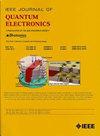Design and Experimental Demonstration of a High-Performance 2 × 2 Restricted Interference MMI Coupler-Based Optical Power Splitter for C-Band Applications
IF 2.1
3区 工程技术
Q3 ENGINEERING, ELECTRICAL & ELECTRONIC
引用次数: 0
Abstract
Silicon waveguide-based optical splitters are fundamental components in the development of advanced functional circuits, including optical switches, routers, modulators, and various optical logic circuits. Among the various approaches, multimode interference (MMI) waveguides are widely employed in optical splitters due to their broad bandwidth, high fabrication tolerance, stability, efficient light confinement, and low transmission loss. In this study, we present the design of an optical splitter based on restricted interference mechanisms, where the precise positioning of input pairs and careful adjustment of the MMI region length are key factors. By applying interference theory, we successfully reduce the length of the RI-MMI coupler. The design undergoes extensive optimization through rigorous 3D-FDTD simulations to ensure optimal performance. Subsequently, we fabricated 11 chip designs using 193-nm deep ultraviolet (DUV) photolithography and plasma-enhanced chemical vapor deposition (PECVD) processes. Performance measurements, conducted through subwavelength grating couplers (SWGC), reveal that our optimized design achieves very low insertion loss (IL) (<5>基于高性能2 × 2受限干涉MMI耦合器的c波段光功率分配器的设计与实验演示
基于硅波导的光分路器是开发先进功能电路的基本组件,包括光开关、路由器、调制器和各种光逻辑电路。其中,多模干涉(MMI)波导以其宽带宽、高制造公差、稳定性、高效光约束和低传输损耗等优点被广泛应用于光分路器中。在这项研究中,我们提出了一种基于受限干涉机制的光分路器的设计,其中输入对的精确定位和MMI区域长度的仔细调整是关键因素。应用干涉理论,成功地减小了RI-MMI耦合器的长度。设计经过严格的3D-FDTD模拟进行了广泛的优化,以确保最佳性能。随后,我们利用193nm深紫外(DUV)光刻和等离子体增强化学气相沉积(PECVD)工艺制作了11个芯片设计。通过亚波长光栅耦合器(SWGC)进行的性能测量表明,我们的优化设计在整个c波段实现了非常低的插入损耗(IL) ($\lt -23$ dB)。此外,该器件具有低纹波、几乎与输入无关的耦合比(CR)和以1555 nm至1565 nm为中心的10 nm范围内平衡的分裂比。值得注意的是,分配器的核心组件被封装在一个超紧凑的占地面积为6~ $ $ m × 65~ $ $ m的范围内。这些卓越的特性使所提出的器件成为电信应用中大规模集成光电路的有希望的候选者。
本文章由计算机程序翻译,如有差异,请以英文原文为准。
求助全文
约1分钟内获得全文
求助全文
来源期刊

IEEE Journal of Quantum Electronics
工程技术-工程:电子与电气
CiteScore
4.70
自引率
4.00%
发文量
99
审稿时长
3.0 months
期刊介绍:
The IEEE Journal of Quantum Electronics is dedicated to the publication of manuscripts reporting novel experimental or theoretical results in the broad field of the science and technology of quantum electronics. The Journal comprises original contributions, both regular papers and letters, describing significant advances in the understanding of quantum electronics phenomena or the demonstration of new devices, systems, or applications. Manuscripts reporting new developments in systems and applications must emphasize quantum electronics principles or devices. The scope of JQE encompasses the generation, propagation, detection, and application of coherent electromagnetic radiation having wavelengths below one millimeter (i.e., in the submillimeter, infrared, visible, ultraviolet, etc., regions). Whether the focus of a manuscript is a quantum-electronic device or phenomenon, the critical factor in the editorial review of a manuscript is the potential impact of the results presented on continuing research in the field or on advancing the technological base of quantum electronics.
 求助内容:
求助内容: 应助结果提醒方式:
应助结果提醒方式:


